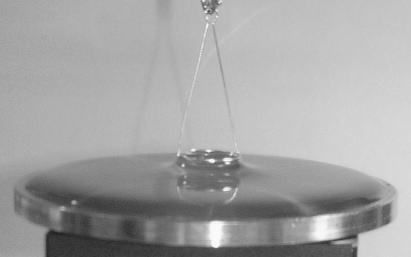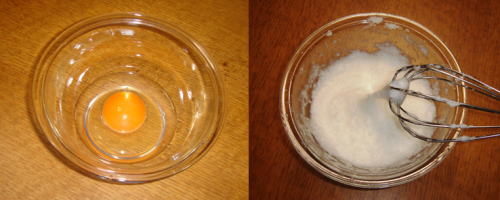|
|
|
| Yohko F. Yano, Associate Professor |
- 1992-2006 Iijima Group, Gakushuin University
|
|
| A special feature of a liquid-vapor interface is that it is a transition zone between the vapor and the bulk liquid. Surprisingly, the thickness of the liquid-vapor interface of water at room temperature was found to be only several angstroms in spite of the fact that its density varies down to 10-5 from the liquid to its vapor. |

Surface Tension Measurement |
| Protein unfolding at an air-water interface |
| The conformation of protein molecules is determined by a balance of various
forces, including van der Waals attraction, electrostatic interaction,
hydrogen bonding, and conformational entropy. When protein molecules encounter
an interface, they are often adsorbed on the interface. The conformation
of an adsorbed protein molecule strongly depends on the interaction between
the protein and the interface. Recent time-resolved investigations have
revealed that protein conformation changes during the adsorption process
due to the protein-protein interaction increasing with increasing interface
coverage. External conditions also affect the protein conformation. |

Protein denaturation at an air-water interface |
| X-ray reflectivity (XR) techniques are powerful tools forexploring surface
phenomena. XR employs an evanescent wave. In contrast to visible light,
the x-ray refractive index of all materials is slightly less than unity.
Consequently, an x-ray beam will be totally reflected at grazing incidence
so that the penetration depth in a material will be of the order of nanometers.
In XR, the electron density profile of the adsorbed film perpendicular
to the interface can be obtained since the angle of the reflected beam
is equal to that of the incident beam. In the angle-scanning method, the
reflected intensity of monochromatic x-rays is recorded as a function of
the incidence angle. Even when synchrotron radiation has been used, there
have been few successful attempts to realize time-resolved XR using this
method, which can provide information on structures that change on a timescale
of minutes. A time resolution of the order of milliseconds has recently
been demonstrated using a multiwavelength dispersive technique. |
| Protein molecules exhibit many vibrational frequencies in infrared (IR)
spectroscopy. The amide I band (1650 cm-1) is sensitive to small variations in molecular geometry and hydrogen bonding
patterns within proteins. It has been extensively used to investigate changes
to secondary structure and conformation in proteins. In principle, different
secondary structures (e.g., alpha-helices, beta-sheets, turns, and unordered
structures) have different CDO stretching frequencies in the amide I region
of the IR spectrum. The main problem of IR spectroscopy of air-water interfaces
is extracting the weak signal of the adsorbed layer from the very strong
absorption of the liquid subphase; this is especially problematic when
the surrounding environment contains water vapor. Attenuated total reflection
(ATR) can be used to overcome this problem. |
Energy dispersive X-ray reflectometer combined with FT-IR
The reflectometer is designed by one of the undergraduated students in
our group. |
|
Liquid interface spectrometer at SPring-8
The reflectometer, equipped with a two-dimensional single X-ray photon-counting
pixel array detector obtained the full range of X-ray specular and off-specular
reflections in an extremely short time (1 s). |
|
Simultaneous multiple angle-wavelength dispersive X-ray reflectometer at
KEK
This X-ray reflectometer can simultaneously measure the whole specular
X-ray reflectivity curve with no need for rotation of the sample, detector
or monochromator crystal during the measurement. A bent-twisted crystal
polychromator is used to realise a convergent X-ray beam which has continuously
varying energy E (wavelength [lambda]) and glancing angle [alpha] to the
sample surface as a function of horizontal direction. |
|
|
|

